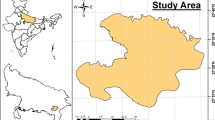Abstract
Intensive groundwater extraction is a changing groundwater system. It is also the main challenge for future groundwater availability. In this study, numerical groundwater flow model was developed in Kombolcha catchment, Ethiopia by using MODFLOW-OWHM. To address this concern, the conceptual model was built by analyzing the hydrogeological data. The groundwater model was calibrated under the steady-state condition to produce the best match between the simulated and observed hydraulic head. The simulated outflow of the MODFLOW model was 358,221.09 m3/day which is nearly equal to 358,221.08 m3/day of groundwater inflow with a difference 0.01 m3/day and zero discrepancies. The subsurface inflow covers the most percentage (76%) in the budget and surface outflow contributes about 66% of the total groundwater outflow. The model result shows that the Kombolcha aquifer system is highly sensitive to change of hydraulic conductivity. Prediction of this aquifer behavior for increasing well withdrawal and decreasing recharge scenarios has been carried out. The effect of increasing withdrawal by 25, 50 and 100% results in a decline of groundwater level by 6.77, 12.15 and 24.37 m, respectively, whereas the effect of decreasing groundwater recharge by the same percentage of withdrawal results in a decline of groundwater level by 4.27, 6.34 and 11.25 m, respectively. This model can be as a tool to understand the aquifer system and sustainable utilization of groundwater resources.










Similar content being viewed by others
Data availability
Some or all data, models, or codes that support the findings of this study are available from the corresponding author upon reasonable request.
References
Anderson MP, Woessner WW (1992) Applied groundwater modeling simulation of flow and advective transport. Academic Press, New York
Anderson MP, Woessner WW, Hunt RJ (2015) Applied groundwater modeling simulation of flow and advective transport, 2nd edn. Academic Press, New York
Aynalem K (2015) Numerical groundwater flow and nitrate transport modeling for the prediction of impacts of land use changes on water quality in Akaki Catchment. Addis Ababa University Graduate Students, School of Earth Science, Addis Ababa
Crowe AS, Shikaze SG, Ptacek CJ (2004) Numerical modelling of groundwater flow and contaminant transport to Point Pelee marsh, Ontario, Canada. Hydrol Process 18:293–314. https://doi.org/10.1002/hyp.1376
Edet A, Abdelaziz R, Merkel B, Okereke C (2014) Numerical groundwater flow modeling of the coastal plain sand aquifer Akwa Ibom state, SE Nigeria. J Water Resour Protect 6:193–201. https://doi.org/10.4236/jwarp.2014.64025
Fouad M, Hussein EE (2018) Assessment of numerical groundwater models. Int J Sci Eng Res 9(6):951–974
Gao H (2011) Groundwater modeling for flow systems with complex geological and hydrogeological conditions. Procedia Earth Planet Sci 3:23–28
Harbaugh AW, McDonald MG (1984) A modular three-dimensional finite-difference groundwater flow modeling. US Geological Survey, Reston
Igboekwe MU, Rao VVSG, Okwueze EE (2008) Groundwater flow modelling of Kwa Ibo River watershed, southeastern Nigeria. Hydrol Process 2:1523–1531. https://doi.org/10.1002/hyp.6530
Koohestani N, Halaghi MM, Dehghani AA (2013) Numerical simulation of groundwater level using MODFLOW software (a case study: Narmab watershed, Golestan province). Int J Adv Biol Biomed Res 1(8):858–873
Kumar CP (2019) An overview of commonly used groundwater modelling software. Int J Adv Res Sci Eng Technol 6(1):7854–7865
Kumar S, Kumar M, Nayak T (2018) Sustainable development of groundwater: a case study of Begamganj block in Bina River Basin of Madhya Pradesh, India. Int J Recent Aspects 5(1):197–200
Malekzadeh M, Kardar S, Shabanlou S (2019) Groundwater for sustainable development simulation of groundwater level using MODFLOW. Groundw Sustain Dev 9:100279. https://doi.org/10.1016/j.gsd.2019.100279
Marnani SA, Chitsazan M, Mirzaei Y, Jahandideh B, Blvd G (2010) Groundwater resources management in various scenarios using numerical model. Am J Geosci 1(1):21–26
Mengistu HA, Demlie MB, Abiye TA, Xu Y, Kanyerere T (2019) Groundwater for Sustainable Development Conceptual hydrogeological and numerical groundwater flow modelling around the Moab Khutsong deep gold mine, South Africa. Groundw Sustain Dev 9:100266. https://doi.org/10.1016/j.gsd.2019.100266
Nigussie AA, Sebhat MY (2016) Numerical groundwater flow modeling of the northern river catchment of the Lake Tana, Upper Blue Basin, Ethiopia. J Agric Environ Int Dev 110(1):5–26. https://doi.org/10.12895/jaeid.20161.380
Nyende J, Tg V, Vermeulen D (2013) Conceptual and numerical model development for groundwater resources management in a regolith-fractured-basement aquifer system. J Earth Sci Clim Change 4(5):156. https://doi.org/10.4172/2157-7617.1000156
Oljira E (2006) Numerical groundwater flow modeling of the Akaki River catchment. Addis Ababa University Graduate Students, School of Earth Science, Addis Ababa
Post VEA, Galvis SC, Sinclair PJ, Werner AD (2019) Evaluation of management scenarios for potable water supply using script-based numerical groundwater models of a freshwater lens. J Hydrol 571:843–855. https://doi.org/10.1016/j.jhydrol.2019.02.024
Satapona A, Prakasa D, Putra E, Hendrayana H (2018) Groundwater flow modeling in the Malioboro, Yogyakarta, Indonesia. Journal of Applied Geology 3:11–22. https://doi.org/10.22146/jag.30
Sathish S, Elango L (2015) Numerical simulation and prediction of groundwater flow in a coastal aquifer of Southern India. J Water Resour Protect 7:1483–1494
Xu X, Huang G, Qu Z, Pereira LS (2011) Using MODFLOW and GIS to assess changes in groundwater dynamics in response to Water Yellow River Basin. Water Resour Manag 2:25. https://doi.org/10.1007/s11269-011-9793-2
Yang Q, Lu W, Fang Y (2011) Numerical modeling of three dimension groundwater flow in Tongliao (China). Procedia Eng 24:638–642. https://doi.org/10.1016/j.proeng.2011.11.2709
Zhou Y, Li W (2011) A review of regional groundwater flow modeling. Geosci Front 2(2):205–214. https://doi.org/10.1016/j.gsf.2011.03.003
Author information
Authors and Affiliations
Corresponding author
Additional information
Publisher's Note
Springer Nature remains neutral with regard to jurisdictional claims in published maps and institutional affiliations.
Rights and permissions
About this article
Cite this article
Azeref, B.G., Bushira, K.M. Numerical groundwater flow modeling of the Kombolcha catchment northern Ethiopia. Model. Earth Syst. Environ. 6, 1233–1244 (2020). https://doi.org/10.1007/s40808-020-00753-6
Received:
Accepted:
Published:
Issue Date:
DOI: https://doi.org/10.1007/s40808-020-00753-6




